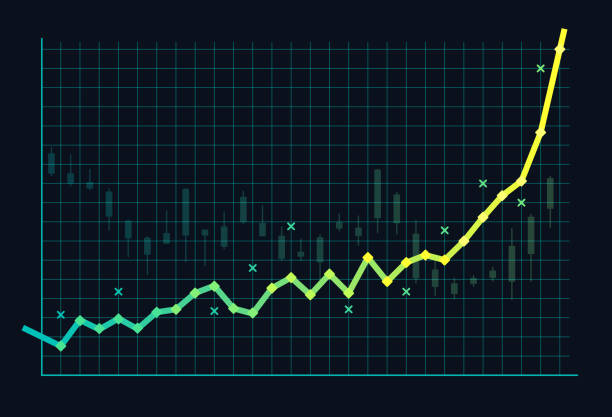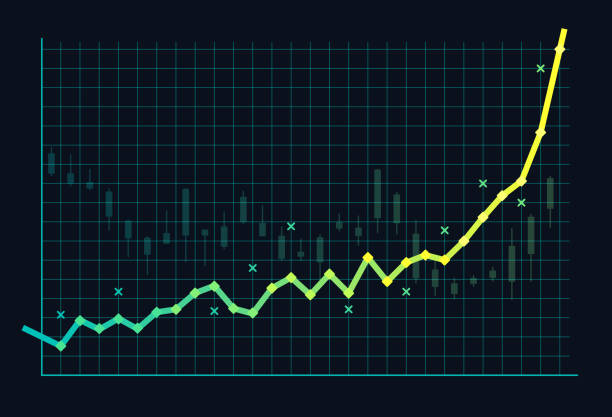

Market Trends and the Art of Strategic Stock Selection
The paths leading to financial success are often winding and full of tricky parts that can test even the most seasoned investors. In today’s environment, where stocks sometimes surge close to their 52‐week highs, there are plenty of positive signals lighting the way: companies unveil new products, take advantage of favorable industry trends, or show improved financial performance. However, as any experienced market follower might say, not every shining opportunity stands the test of time. Investors must steer through the complications of short-term market momentum while keeping an eye on long-term viability.
In this editorial, we’ll take a closer look at three distinct stocks that illustrate the various paths available for investors. We’ll dig into the facts behind Great Lakes Dredge & Dock (GLDD), Old Republic International (ORI), and Cincinnati Financial (CINF). By analyzing these companies in detail, we aim to provide insight into the tangled issues that can determine whether a seemingly strong performer has lasting appeal or whether investors should be cautious about rapid gains.
Understanding the Landscape of 52-Week High Stocks
Stocks trading near their 52-week highs often reflect recent success stories. Investors are naturally attracted by the promise of new market potential and the excitement surrounding product launches and service expansions. However, behind these impressive figures lurk some tricky parts. There is always the possibility of overvaluation and vulnerability to corrections when sentiment shifts.
This market segment is full of subtle parts where fine details matter. The rise of these stocks can represent a carefully cultivated success story, but it is crucial to figure a path through the sometimes complicated pieces of financial metrics, market forecasts, and the underlying economic forces at play.
Key Factors in Stock Evaluations Near Their Peaks
When stocks maintain levels near their yearly highs, several crucial elements come into play. These include:
- Recent positive developments: New product launches, robust revenues, and strategic expansion.
- Sector-specific trends: Some industries naturally witness significant growth spurts during certain periods.
- Investor sentiment: Market enthusiasm can drive prices up, sometimes beyond what fundamentals justify.
- Financial performance: Metrics like forward P/E, book value per share, and gross margins are essential to understand potential risks.
It is essential to take the wheel when managing your portfolio in such dynamic circumstances. Balancing the short-term excitement against the long-term potential requires you to dive in and get into the nitty-gritty of each company before making any final decisions.
Great Lakes Dredge & Dock: A Closer Look at a Risky Proposition
Founded originally as Lydon & Drews dredging company, Great Lakes Dredge & Dock has grown into a player in dredging services, land reclamation, and coastal protection projects both domestically and internationally. Even though the company appears to be gaining momentum, several factors suggest that investors tread carefully.
Concerns Over Backlog Growth and Business Model Viability
Recent data indicates that Great Lakes Dredge & Dock’s backlog growth has only inched up by a modest 4.2% on average over the past two years. This rate of growth may point to a need for the company to tweak its product roadmap or to reconsider its go-to-market strategy. In a dynamic global economy with countless twists and turns, such sluggish growth can be one of those subtle details that hints at deeper challenges.
The company’s gross margin stands at 16.9%, which is below that of its competitors. This situation leaves less money available to invest in areas such as marketing, research and development, or other strategic initiatives. Moreover, its history of burning cash casts a shadow of doubt over the long-term viability of its business model.
Valuation and Market Sentiment
At a stock price of approximately $11.66, Great Lakes Dredge & Dock trades at a forward price-to-earnings (P/E) ratio near 13.2. While some investors might see this as a potential bargain, the underlying issues suggest that one must figure a path through these risky waters. The lack of robust growth, combined with a weaker margin and an uncertain capacity to generate sustainable earnings, has led many experts to classify GLDD among the stocks to watch out for, rather than ones to add to a long-term portfolio.
Quick Reference: Key Metrics for GLDD
| Metric | Value |
|---|---|
| One-Month Return | +5.7% |
| Gross Margin | 16.9% |
| Backlog Growth (2 years average) | 4.2% |
| Forward P/E Ratio | 13.2x |
| Stock Price | $11.66 |
This table highlights some of the fine points that potential investors need to consider when weighing the risks versus rewards associated with GLDD. With a detailed look at these indicators, it becomes clear that while there is some momentum, the underlying issues may prove intimidating over the long haul.
Old Republic International: A Legacy with Lingering Challenges
Old Republic International has been rooted in the insurance sector since 1923, having weathered nearly a century of economic ups and downs. This diversified insurance holding company offers property, liability, title, and mortgage guaranty insurance. Despite its storied past, the company now faces a number of challenges that merit caution from investors.
The Challenges of Modest Policy Growth and Earnings Underperformance
One of the most telling signs of Old Republic International’s current predicament is its modest growth in insurance policies. Over the past five years, the annual growth rate has hovered around 3.3%. This underperformance stands in contrast to many financial institutions that regularly show stronger policy expansion. It’s one of those subtle details that investors need to keep an eye on.
In addition to modest policy growth, the company’s earnings have not kept pace with sector averages. With a historical annual increase in earnings per share (EPS) of just about 9.9%, the performance lags behind the more robust growth seen elsewhere. Such a situation may signal that the company is struggling to keep up with the evolving market demands and competitive pressures.
Potential Credit Quality Issues and Market Valuation
Another vital concern for Old Republic International is the outlook for its book value per share, which is projected to decline by about 1% over the next 12 months. This forecast raises concerns about potential credit quality issues that could become a significant hurdle for future growth. The company is currently trading at around $45.09 per share, with a forward price-to-book (P/B) ratio of 1.7x—a valuation that seems reasonable at first glance but must be analyzed in the context of its overall performance challenges.
Summary of ORI’s Key Performance Metrics
| Metric | Value |
|---|---|
| One-Month Return | +8% |
| Annual Policy Growth (5-year average) | 3.3% |
| EPS Annual Growth (Last 2 years) | 9.9% |
| Projected Book Value Change (Next 12 months) | -1% |
| Forward P/B Ratio | 1.7x |
| Stock Price | $45.09 |
Clearly, while Old Republic International enjoys a rich legacy and resilient presence in the insurance industry, there are a number of tricky parts investors must figure a path around before chalking it up as a surefire buy. The contrast between its market heritage and current financial performance points to a need for caution and further assessment.
Cincinnati Financial: A Beacon of Robust Growth
Founded in 1950 by independent insurance agents seeking consistent market options, Cincinnati Financial has grown into a company that serves nearly 46 states with property casualty and life insurance, as well as various related financial services. In contrast to the companies discussed earlier, Cincinnati Financial stands out as a stock to watch closely.
Driving Factors Behind Cincinnati Financial’s Momentum
The company has demonstrated a significant expansion in net premiums earned, which increased by an impressive 12.1% annually over the past two years. This highlight is one of the many detailed pieces that suggest Cincinnati Financial is managing its way through market challenges with notable success. Equity repurchases have bolstered shareholder returns, and the company has enjoyed strong earnings per share growth at an annual rate of 21.6% over the last five years.
Furthermore, the annual growth in book value per share, at an outstanding rate of 20.8% over the past two years, is a critical metric that showcases strong capital accumulation. Such robust metrics indicate that Cincinnati Financial is not only successfully riding the current market cycle, but it is also paving the way for long-term resilience and investor confidence.
Current Valuation and Investment Appeal
Cincinnati Financial is trading at a significantly higher stock price, currently around $163.72 per share, with a forward price-to-book (P/B) ratio of about 1.6x. When contrasted with the earlier two companies, the metrics for Cincinnati Financial suggest a stock that is efficiently balancing market enthusiasm with conservative financial management. Investors who appreciate a mix of stability and growth might find this stock a worthy opportunity to add to their portfolios.
Essential Dashboard of CINF’s Performance
| Metric | Value |
|---|---|
| One-Month Return | +5.7% |
| Net Premiums Earned Growth (Annual) | 12.1% |
| Earnings Per Share Growth (5-year average) | 21.6% |
| Book Value Per Share Growth (Annual, Last 2 years) | 20.8% |
| Forward P/B Ratio | 1.6x |
| Stock Price | $163.72 |
The data in this table shows a company that is performing well across a range of metrics. With its impressive capital accumulation, strong premium growth, and effective share repurchase initiatives, Cincinnati Financial provides one of the clearest examples of a stock that can generate exhilarating momentum without the overhanging risks observed in others.
High-Quality Stocks for Every Market Condition
In a period where yesterday’s successes may not necessarily predict tomorrow’s wins, the significance of assembling a portfolio based on long-term, resilient opportunities cannot be overstated. It is increasingly clear in today’s fast-paced environment that a handful of heavily crowded stocks can be intimidating, while a diversified collection featuring hidden winners might be the key to sustaining a robust portfolio.
Investors must find their way through the maze of evolving market trends, the pitfalls of short-term exuberance, and the unpredictable twists and turns of the financial world. The list of strong momentum stocks, including some well-known success stories like Nvidia and under-the-radar opportunities such as Tecnoglass, is a testament to the benefits of diversifying. For instance, Nvidia experienced a phenomenal growth of 1,326% between June 2020 and June 2025. Similarly, Tecnoglass, once a micro-cap company, saw an astonishing 1,754% growth over five years.
Steps to Building a Robust Investment Strategy
Here are some critical approaches to consider when developing your portfolio strategy:
- Reassess Your Portfolio Regularly: With market conditions changing rapidly, it’s essential to manage your way through recurring portfolio reviews. Look for small distinctions in stock performance and be prepared to adjust your holdings as necessary.
- Diversify Across Sectors: Avoid placing all your investments in one crowded sector. Instead, spread your risk by including a mix of stocks from different industries, such as technology, finance, and healthcare.
- Focus on Fundamental Strengths: Key metrics such as forward P/E ratios, book value per share, and growth rates offer valuable hints about potential risks. These figures provide a roadmap to help you figure a path to the stocks that are performing well for the right reasons.
- Stay Abreast of Market Trends: The market is loaded with issues and constantly changing. Keep a watchful eye on emerging trends, regulatory environments, and shifts in consumer behavior that could affect your investments.
- Consider Long-Term Sustainability: Emphasize companies with proven track records for resilience and reliability over those simply riding high on temporary momentum.
This strategy, while not a guarantee of success, can help investors find their next big winner without being misled by short-term hype. By taking a closer look at high-quality stocks such as Cincinnati Financial—and carefully weighing the risks associated with companies like Great Lakes Dredge & Dock and Old Republic International—investors can build a portfolio that promises balanced growth and reduced vulnerability to market corrections.
Finding Your Path Through a Volatile Market
Investors often find themselves in nerve-racking situations when trying to balance short-term gains with long-term stability. The path is full of confusing bits and tricky parts, making it essential to rely on thorough research and detailed analysis rather than purely following market sentiment. Using curated research reports and detailed performance metrics can offer critical insights into whether a stock is positioned for sustained growth or one that might experience severe corrections in the coming months.
It is super important to maintain a neutral stance when analyzing any stock. While some companies continue to thrive despite challenging market conditions, others may be on the brink of a turnaround or face continued financial and operational pressures. Thus, building a strategy that incorporates rigorous due diligence is a must-have for anyone serious about long-term investment success.
Utilizing Research Reports and Market Analytics
One of the best tools in an investor’s arsenal is access to in-depth, independent research reports. These reports offer a window into the small distinctions between companies that might otherwise appear similar based solely on headline metrics. Organizations like StockStory provide free research reports for active members, covering essential topics such as:
- Future earnings projections.
- Detailed breakdowns of profit drivers.
- Comparative analyses of industry peers.
- Insights into operational challenges and opportunities.
By sorting out the market information from these comprehensive resources, investors can get a clearer picture of where each company stands and what challenges lie ahead. It is this depth of analysis that often separates a successful investment strategy from one that is more speculative and off-putting.
Taking a Closer Look at Critical Indicators for Investment Decisions
While each company has its own narrative, there are several key indicators that are crucial regardless of the industry sector. Investors should consider factors such as:
- Growth in Earnings Per Share (EPS): A strong indicator of a company’s profitability over time. While some companies show modest growth, others—like Cincinnati Financial—demonstrate robust momentum through consistent EPS increases.
- Backlog Growth: For service-oriented industries like those served by Great Lakes Dredge & Dock, backlog growth offers insight into future revenue possibilities. Even marginal increases need to be assessed carefully within the greater competitive landscape.
- Gross Margin: A company’s ability to generate profit is often reflected in its gross margin. Lower margins might indicate less flexibility in reinvesting back into the business, a trend seen in GLDD compared to its peers.
- Book Value Per Share: This metric is critical for insurance and financial institutions, offering a snapshot of a company’s accumulated capital. A projected decline in book value per share, as anticipated with Old Republic International, can signal challenging credit conditions that need attention.
- Forward Valuation Ratios: Ratios such as the forward price-to-earnings (P/E) or price-to-book (P/B) provide clues on whether the stock is reasonably priced relative to its earnings potential. An outlier in these ratios may warrant further investigation.
By piecing together these essential metrics, investors can figure a path through the maze of opinions and market narratives to build a comprehensive view of each potential investment. It is this methodical approach that helps separate the wheat from the chaff in ever-changing market conditions.
The Role of Investor Sentiment and Market Psychology
Investor sentiment plays a hidden yet critical role in stock performance. Often, the market’s appetite for upward momentum can lead to stock valuations that exceed what traditional metrics might suggest. While this sentiment-driven growth can be exciting, it also brings along an element of risk, especially when factors like weak backlog growth or modest earnings expansion are in play.
The challenge lies in getting around the overwhelming flood of market hype and instead focusing on small distinctions and the subtle parts that truly indicate a company’s health. Whether it’s understanding the potential downside of a cash-burning history or the upside of consistent book value growth, investors must research the fine points to avoid unexpected pitfalls.
Strategies to Manage Emotional Investing
To manage your way through the maze of investor sentiment, consider these strategies:
- Rely on data: Let the numbers speak for themselves. Analyze metrics such as EPS growth, gross margins, and forward valuation ratios rather than simply reacting to market hype.
- Stick to a long-term plan: Even in times of rapid change, maintaining a well-thought-out strategy is critical. Diversification and periodic portfolio reviews can help temper the short-term noise.
- Seek multiple sources: Rely on various reports and expert opinions to get a complete picture of a company’s prospects. This can provide you with the confidence to figure a path through conflicting interpretations.
- Exercise patience: Not every rapid surge in stock price is sustainable. Recognizing when the market is loaded with issues or when a stock is simply following a speculative trend is a skill that takes time to hone.
By taking the time to thoroughly analyze market data and by distinguishing between short-term exuberance and long-term growth potential, investors can avoid the nerve-racking pitfalls of emotional decisions and focus on building a resilient portfolio.
The Bigger Picture: Investing in a Shifting Economic Environment
Today’s market is an intricate tapestry of evolving trends, emerging technologies, and shifting consumer habits. In such a dynamic setting, it is critical for investors to remain both flexible and focused on key performance metrics that speak to a company’s future value rather than its immediate past performance.
Companies like Cincinnati Financial remind us that with careful scrutiny and a commitment to sound fundamentals, it is possible to identify stocks that not only ride the wave of current trends but also have the substance to deliver long-term gains. Conversely, entities like Great Lakes Dredge & Dock and Old Republic International illustrate the importance of being cautious even when market sentiment seems positive.
What Does This Mean for the Average Investor?
For the everyday investor, the primary challenge is to distinguish between fleeting excitement and sustainable growth. While it may feel tempting to jump on the bandwagon of 52‐week high stocks, carefully analyzing underlying metrics and company fundamentals is key to avoiding potential pitfalls.
Here are a few takeaways to consider:
- Always look behind the headline gains. A stock’s short-term return, while impressive, is only one part of the success story.
- Monitor core financial ratios and growth trajectories. Understanding ratios such as forward P/E and P/B can offer insight into whether a stock is truly a bargain or if it’s riding high on market sentiment.
- Diversification remains your friend. By spreading investments across different sectors with a mix of growth-oriented and stable companies, you can reduce the impact of unexpected market corrections.
- Integrate research reports into your decision-making process. Free, high-quality research—from sources like StockStory—can be invaluable in uncovering the little twists and hidden complexities of a company’s performance.
This balanced approach to stock selection helps in constructing a portfolio that is not only reactive to market trends but also robust enough to endure the inevitable corrections and shifts that characterize modern financial markets.
Conclusion: Balancing Optimism with Caution in Your Investment Journey
As we work through the evolving scenarios in today’s financial markets, the stories behind each stock remind us that both potential and risk reside in every corner of the investment world. There is genuine value in understanding why companies like Cincinnati Financial continue to generate investor excitement through strong growth metrics, while equally important is the careful analysis required to identify the pitfalls that may lie hidden in stocks such as Great Lakes Dredge & Dock and Old Republic International.
Investors must dig into the available data, taking the time to figure a path through those complicated pieces and subtle details that influence stock performance. In doing so, they position themselves well to reap the rewards not only of short-term victories but of sustainable, long-term growth.
This editorial has aimed to provide a balanced perspective on three important stocks, mixing market sentiment with rigorous analysis. As you move forward in your investment journey, remember that while market highs can be enticing, a well-rounded strategy that factors in both growth potential and inherent risks will ultimately prove to be the super important key to long-lasting success.
Whether you are an experienced investor or just starting out, keep a keen eye on financial reports, stay updated with market trends, and do not shy away from taking a closer look at those hidden complexities. Through a blend of informed research and prudent decision-making, you can successfully navigate the many twists and turns that make the stock market a challenging yet potentially rewarding landscape.
In closing, investing in high-quality stocks for all market conditions is not merely about chasing the next big surge—it’s about constructing a resilient portfolio that can withstand both the exuberance and the inevitable dips. As you continue to take the wheel in your financial journey, consider this balanced approach your guide to a future of thoughtful, well-informed decisions.
Originally Post From https://stockstory.org/us/stocks/nasdaq/gldd/news/buy-or-sell/1-surging-stock-with-solid-fundamentals-and-2-we-brush-off
Read more about this topic at
Be Wary of Momentum Investing Strategies
A Comprehensive Guide to Momentum Trading Strategies …


